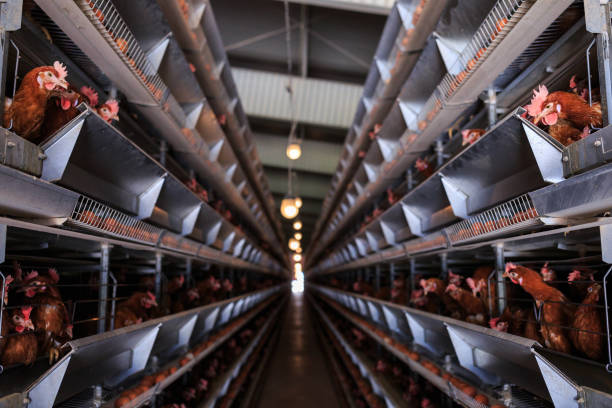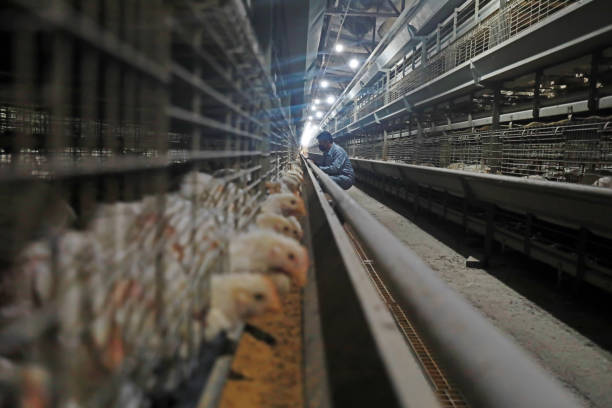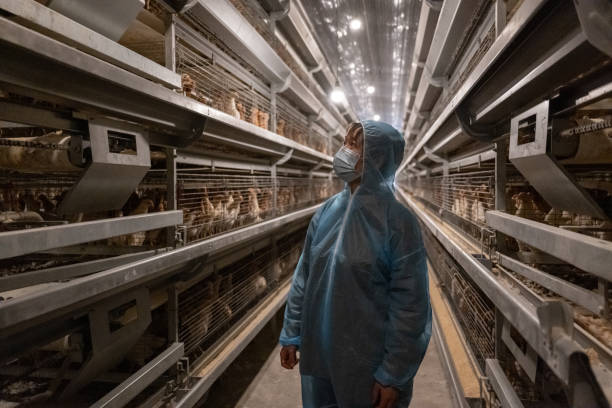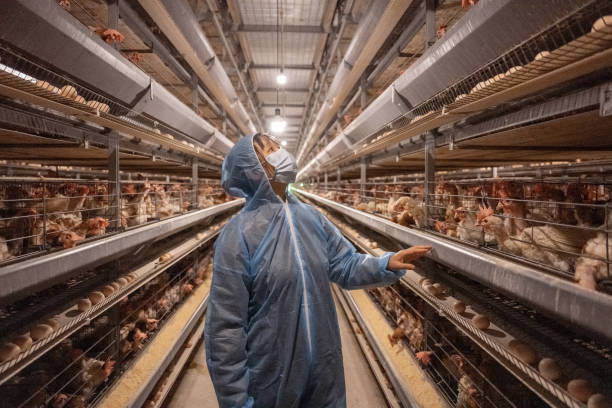Guide to Building a Profitable 150,000 Broiler Chicken Farm in Nigeria
Guide to Building a Profitable 150,000 Broiler Chicken Farm in Nigeria
So, you’re thinking about diving into the deep end and establishing a 150,000 broiler chicken farm in Nigeria? That’s ambitious, I like it! Venturing into broiler farming on a large scale in Nigeria can be a rewarding experience if approached strategically. This guide aims to provide you with a detailed roadmap to navigate the complexities of building and managing a profitable broiler operation of this size, right from planning to execution. It’s a hefty undertaking, but with the right planning and execution, you can be well on your way to success.

Phase 1: Planning and Preparation
Before you even think about buying your first chick, meticulous planning is crucial. This phase involves market research, site selection, farm design, and securing the necessary financing.
Market Research: Nigerian poultry market is dynamic, influenced by factors like consumer demand, feed prices, and seasonal variations. Conduct a thorough market analysis to understand current broiler prices, demand trends, and potential competitors in your target region. Where are you planning to sell? What are the prevailing prices? Who are your major competitors, and what are their strengths and weaknesses? Knowing your market inside and out is non-negotiable. This will also inform your pricing strategy and help you identify potential niche markets, like supplying to hotels, restaurants, or specific processing plants.
Site Selection: The location of your farm is paramount. You need to consider several factors:
Land Availability and Cost: You’ll need a substantial plot of land to accommodate your 150,000 birds and associated infrastructure. Land prices vary considerably across Nigeria, so conduct a comprehensive search to find a suitable location that matches your budget.
Accessibility: The farm should be easily accessible by road for transporting feed, chicks, and finished products. Consider the proximity to major markets and processing plants. Poor road access will add to your transport costs and potentially lead to delays.
Water Source: Reliable and clean water is essential for broiler production. Ideally, you should have access to a borehole or a consistent well. Test the water quality to ensure it meets the required standards for poultry farming.
Electricity: Consistent electricity supply is vital for climate control, lighting, and powering automated systems such as feeding and water systems. Explore options like connecting to the national grid, using generators, or investing in renewable energy sources like solar power. Consider the cost-effectiveness and reliability of each option.
Biosecurity: Choose a site that is relatively isolated from other poultry farms to minimize the risk of disease transmission. The area should also be free from potential environmental hazards such as industrial pollutants or excessive noise.
Farm Design and Infrastructure: This is where you start visualizing your farm. Based on experience helping farms in Nigeria, I tend to recommend deep-litter systems for smaller farms, but with 150,000 birds, you really need to consider automated cage systems as the costs can be significantly cheaper in the long run.
Housing: Design your broiler houses to provide adequate space for the birds to move freely and access feed and water. Allow roughly 1 square foot per bird. A well-ventilated environment is crucial for maintaining bird health and reducing the risk of disease. You’ll need multiple houses to properly manage such a large flock.

Feeding and Watering Systems: Invest in proper automated feeding and watering systems. These systems will need to be durable and designed for the specific needs of broiler chickens. Automation minimizes labor costs and ensures consistent feed and water availability.
Waste Management: A proper waste management system is critical for preventing environmental pollution and maintaining a healthy farm environment. Consider composting, biogas production, or selling the manure as fertilizer.
Financing Your Project: Setting up a 150,000-broiler farm requires substantial capital investment. Explore different financing options:
Personal Savings: Using your own savings is often the initial step.
Loans: Approach commercial banks, agricultural development banks, or microfinance institutions that offer loans specifically for agricultural projects. Prepare a detailed business plan to showcase the viability of your farm and your ability to repay the loan.
Grants and Subsidies: Research government programs and initiatives that provide grants or subsidies to poultry farmers. These programs can significantly reduce your initial investment costs.
Crowdfunding: Consider crowdfunding as an alternative way to raise capital, especially if you have a compelling story or plan to incorporate sustainable practices.
Phase 2: Farm Setup and Equipment Procurement
Once you have secured funding and finalized your farm design, you can begin the process of setting up the infrastructure and procuring the necessary equipment.
Construction: Engage experienced contractors to construct your broiler houses according to the approved design. Ensure that the construction meets the required standards for ventilation, insulation, and structural integrity.
Equipment Installation: Install the feeding and watering systems, ventilation equipment, lighting, and other essential machinery. Ensure that all equipment is properly calibrated and functioning correctly.
Biosecurity Measures: Implement strict biosecurity protocols to prevent the introduction and spread of diseases. This includes installing foot baths, restricting access to the farm, and implementing regular cleaning and disinfection procedures.
Staff Recruitment and Training: Hire a competent farm manager and other essential staff, such as farmworkers, veterinarians, and security personnel. Provide them with thorough training on broiler farming practices, biosecurity protocols, and farm management procedures.
Phase 3: Broiler Production and Management
This is where the rubber meets the road. Effective broiler production relies on diligent management, proper feeding, and vigilant disease prevention.
Chick Procurement: Purchase high-quality day-old chicks from a reputable hatchery. Ensure that the chicks are vaccinated against common poultry diseases. Consider factors like breed characteristics, growth rate, and disease resistance when selecting the chicks.
Brooding: Provide a warm and comfortable environment for the chicks during the brooding phase (the first few weeks of life). Use brooding lamps or gas heaters to maintain the appropriate temperature. Ensure that the chicks have access to clean water and high-quality starter feed.
Feeding: Feed the broilers a balanced diet that meets their nutritional requirements at each stage of growth. Consult with a poultry nutritionist to develop a feeding program tailored to your specific needs. Monitor feed consumption and adjust the feeding program as necessary.
Water Management: Provide the broilers with a constant supply of clean and fresh water. Regularly clean the water troughs or automatic drinkers to prevent contamination. Monitor water consumption to detect any potential health problems.
Ventilation: Maintain proper air circulation in the broiler houses to remove excess moisture, ammonia, and carbon dioxide. Adjust the ventilation based on the weather conditions and the age of the birds.
Disease Prevention: Implement a comprehensive disease prevention program that includes regular vaccination, biosecurity measures, and prompt treatment of sick birds. Consult with a veterinarian to develop a vaccination schedule and disease management plan. Common diseases to watch out for include Newcastle disease, infectious bursal disease (Gumboro), and coccidiosis.
Record Keeping: Maintain accurate records of all farm activities, including feed consumption, weight gain, mortality, and medication usage. This information will help you track performance, identify potential problems, and make informed management decisions.
Phase 4: Harvesting and Marketing
Once the broilers have reached the desired market weight, you can begin harvesting and marketing them.
Harvesting: Handle the broilers carefully during harvesting to minimize stress and bruising. Use proper catching techniques and transport the birds to the processing plant in a timely manner.
Processing or Sale: You can either process the broilers yourself (if you have the necessary facilities) or sell them to a processing plant. If you are processing them yourself, ensure that you have the necessary equipment and follow proper hygiene and food safety standards.
Marketing and Sales: Develop a marketing strategy to reach your target customers. This may involve selling directly to retailers, restaurants, hotels, or consumers. Consider offering different product options, such as whole chickens, cut-up parts, or value-added products like marinated chicken.

Key Considerations for Success
Beyond the logistical and operational aspects, here are some key considerations that will significantly impact the profitability of your 150,000-broiler farm:
Feed Efficiency: Feed costs typically account for 60-70% of the total production cost. Improving feed efficiency – the amount of feed required to produce a kilogram of broiler meat – is crucial for maximizing profitability. This involves optimizing the feeding program, improving bird health, and minimizing feed wastage.
Mortality Rate: High mortality rates can significantly reduce your profitability. Implement effective disease prevention measures, provide a comfortable environment for the birds, and monitor their health closely to minimize mortality. Aim for a mortality rate of below 5%.
Market Price Fluctuations: Broiler prices can fluctuate due to seasonal variations, supply and demand dynamics, and other factors. Stay informed about market trends and adjust your production schedule accordingly. Consider diversifying your marketing channels to reduce your reliance on a single buyer.
Biosecurity: I can’t stress this enough. Biosecurity needs to be a religion on your farm. It’s cheaper to prevent disease than to treat it.
Labor Management: Effective labor management is crucial for ensuring that farm operations run smoothly and efficiently. Provide your workers with adequate training, fair compensation, and a positive working environment.
Sustainability: Incorporate sustainable practices into your farming operations. This includes efficient use of water and energy, proper waste management, and responsible use of antibiotics. Consumers are increasingly demanding sustainably produced products, and adopting these practices can give you a competitive advantage.
Challenges and How to Overcome Them
Running a large-scale broiler farm in Nigeria isn’t without its challenges. Being prepared for potential roadblocks is half the battle.
High Feed Costs: Explore alternative feed ingredients, such as locally sourced grains and protein sources, to reduce your reliance on expensive imported feed. Negotiate favorable prices with feed suppliers by buying in bulk.
Disease Outbreaks: Implement strict biosecurity measures, vaccinate your birds regularly, and consult with a veterinarian promptly if you suspect a disease outbreak.
Electricity Shortages: Invest in a backup generator or explore alternative energy sources such as solar power to ensure a continuous electricity supply.
Theft and Security: Implement robust security measures to protect your farm from theft and vandalism. This includes hiring security personnel, installing security cameras, and erecting a perimeter fence.
Building a profitable 150,000 broiler chicken farm in Nigeria requires careful planning, diligent execution, and a willingness to adapt to changing market conditions. By following the guidelines outlined in this article, you can increase your chances of success and build a thriving poultry business. Remember to seek advice from experienced poultry farmers and agricultural experts to optimize your operations and stay ahead of the curve. Good luck, and happy farming!





